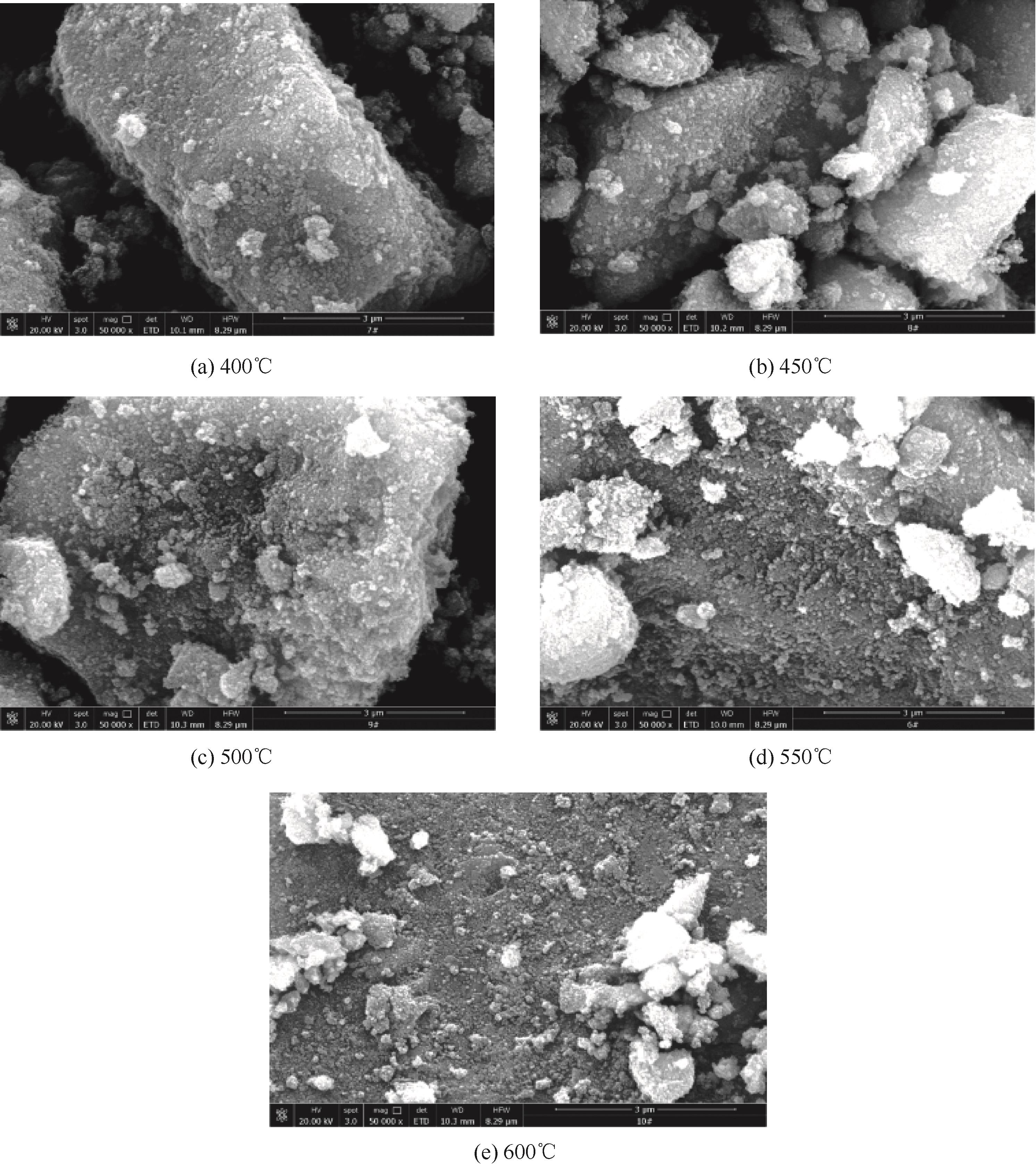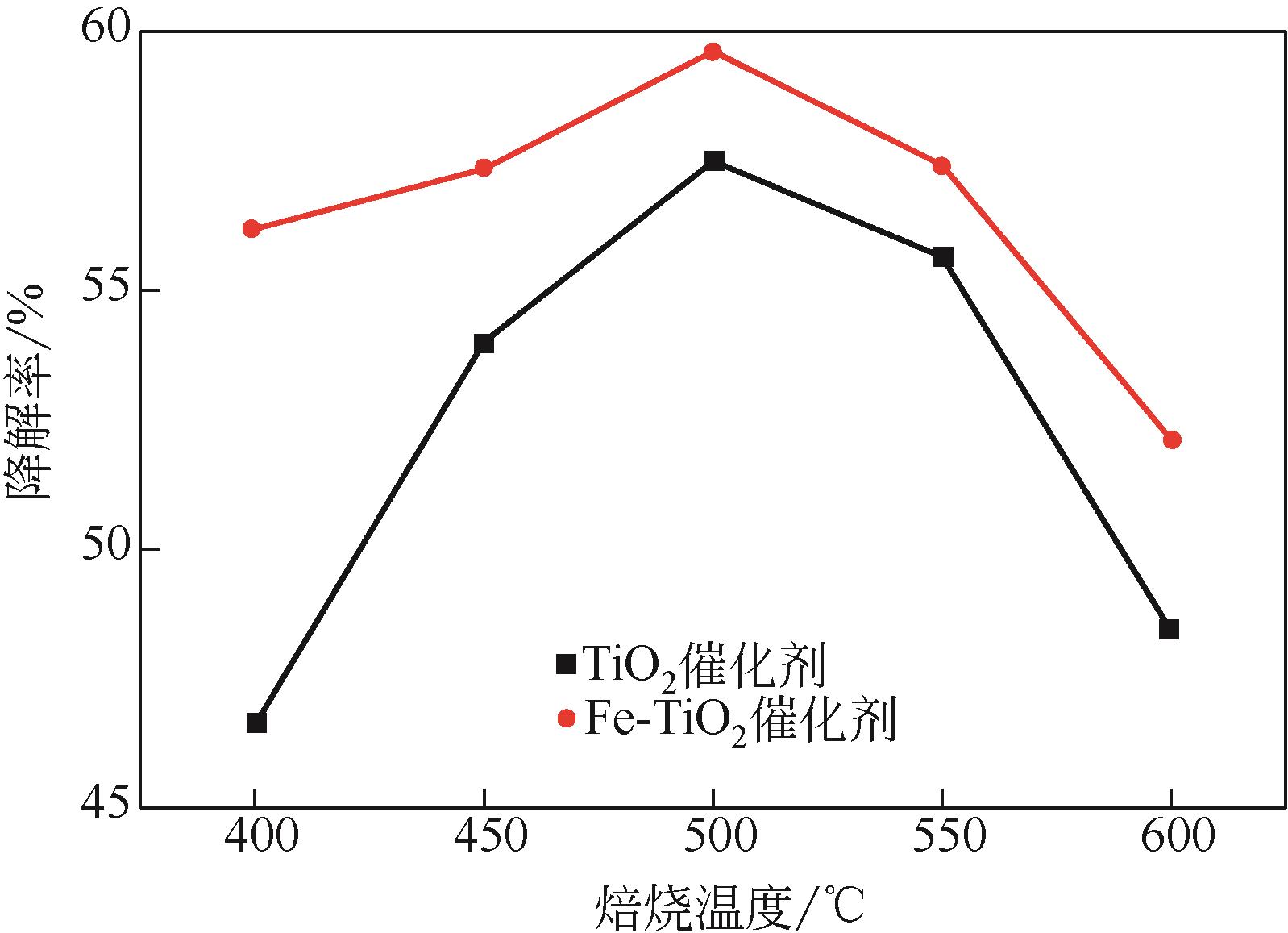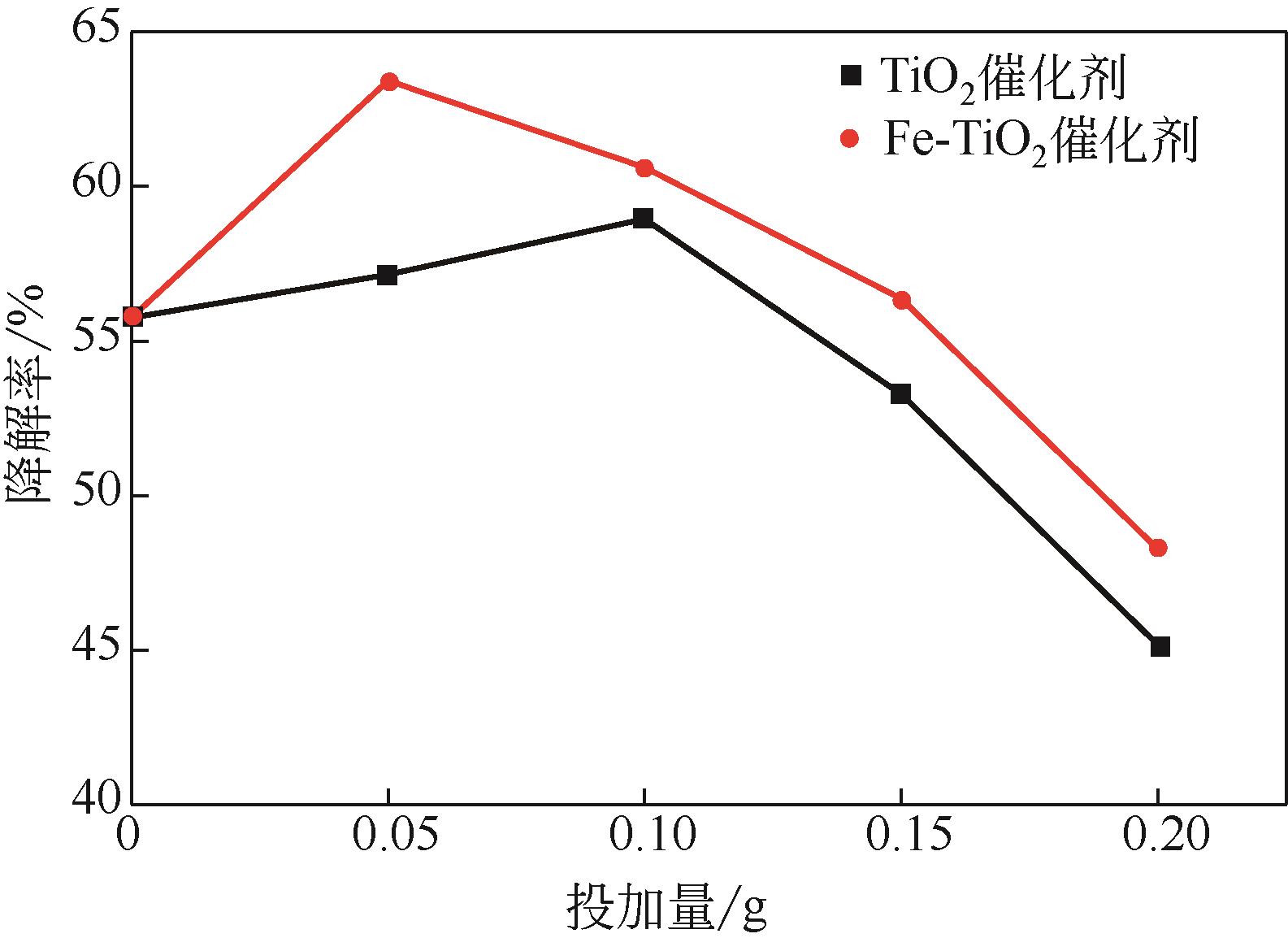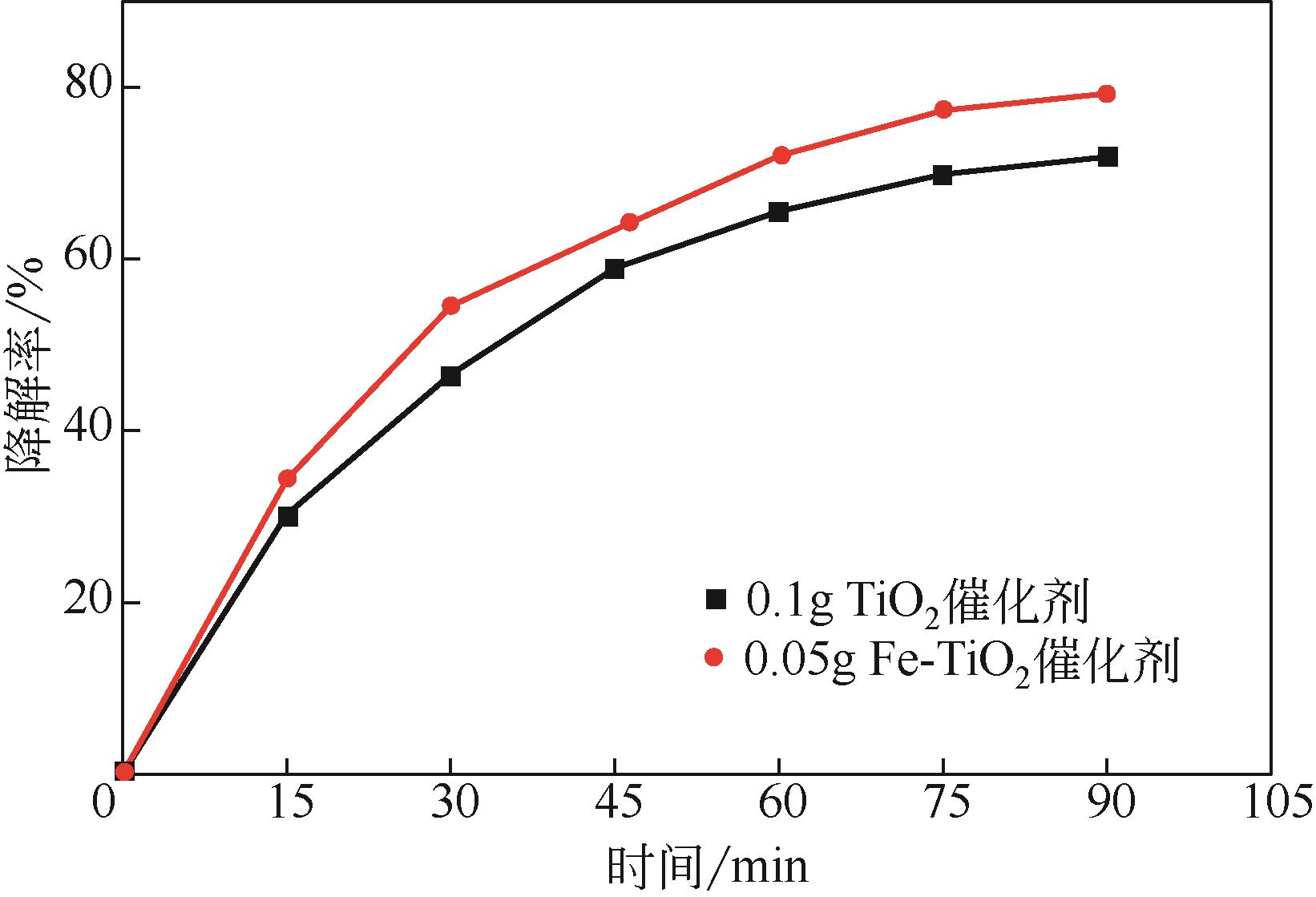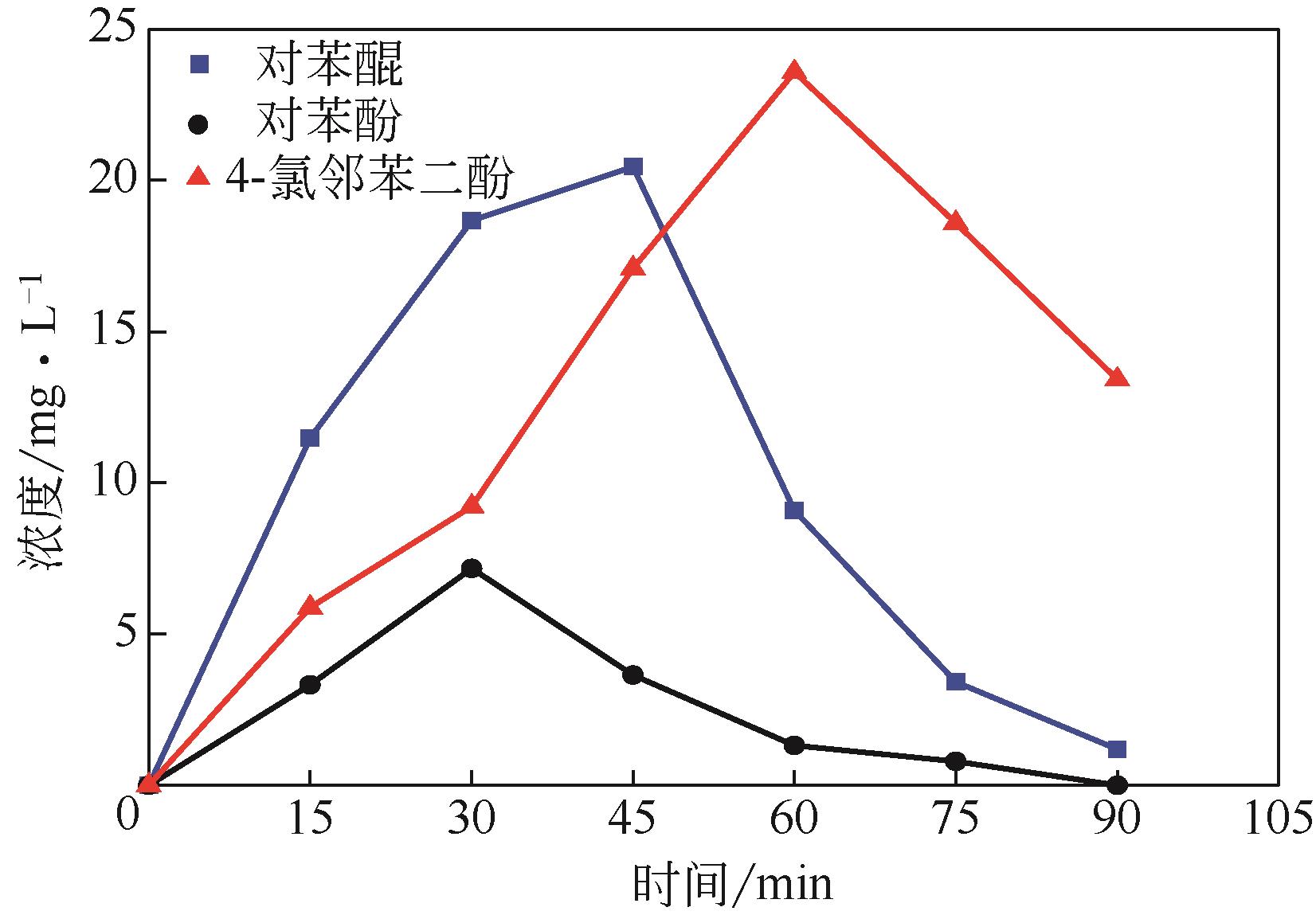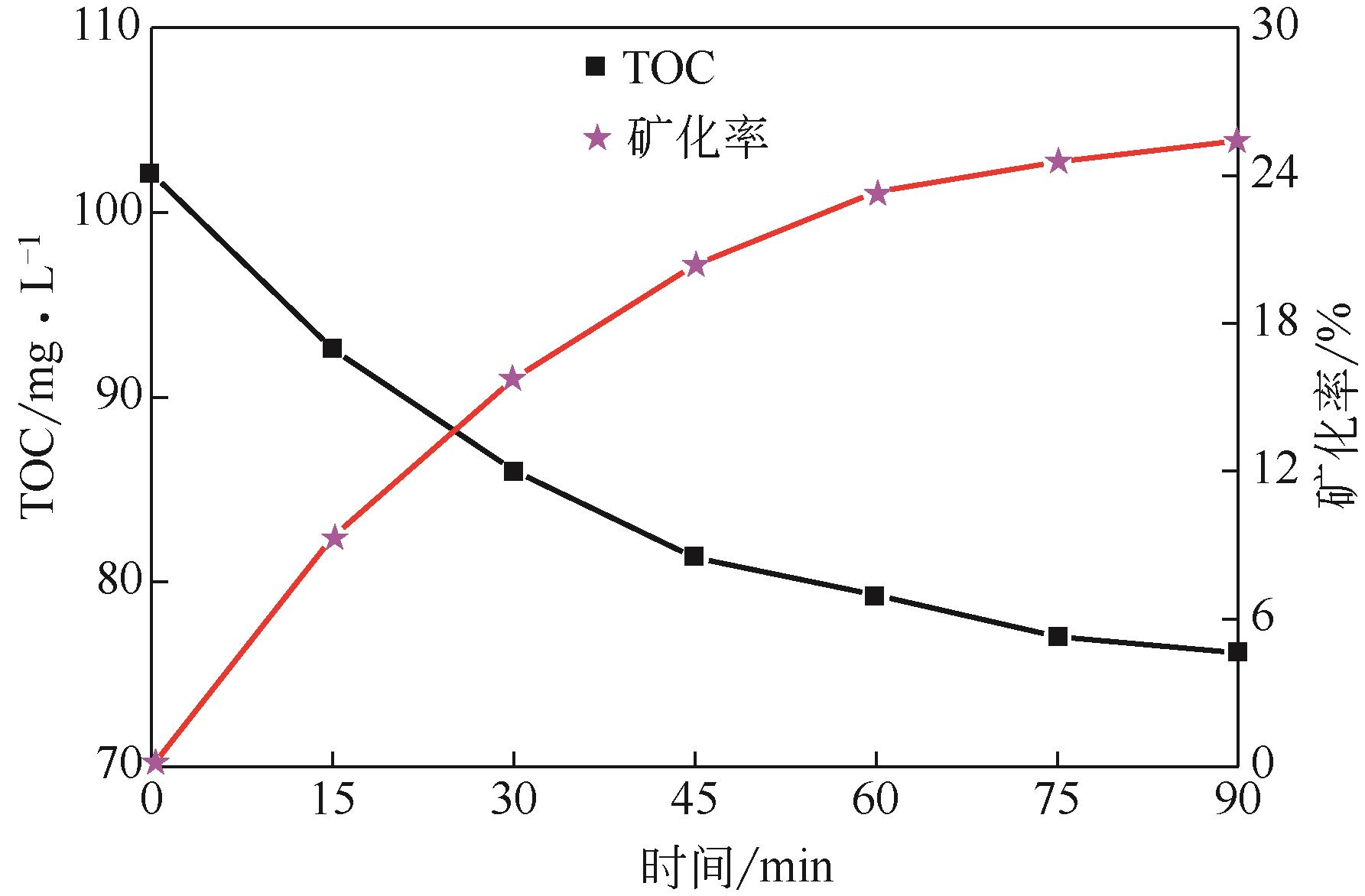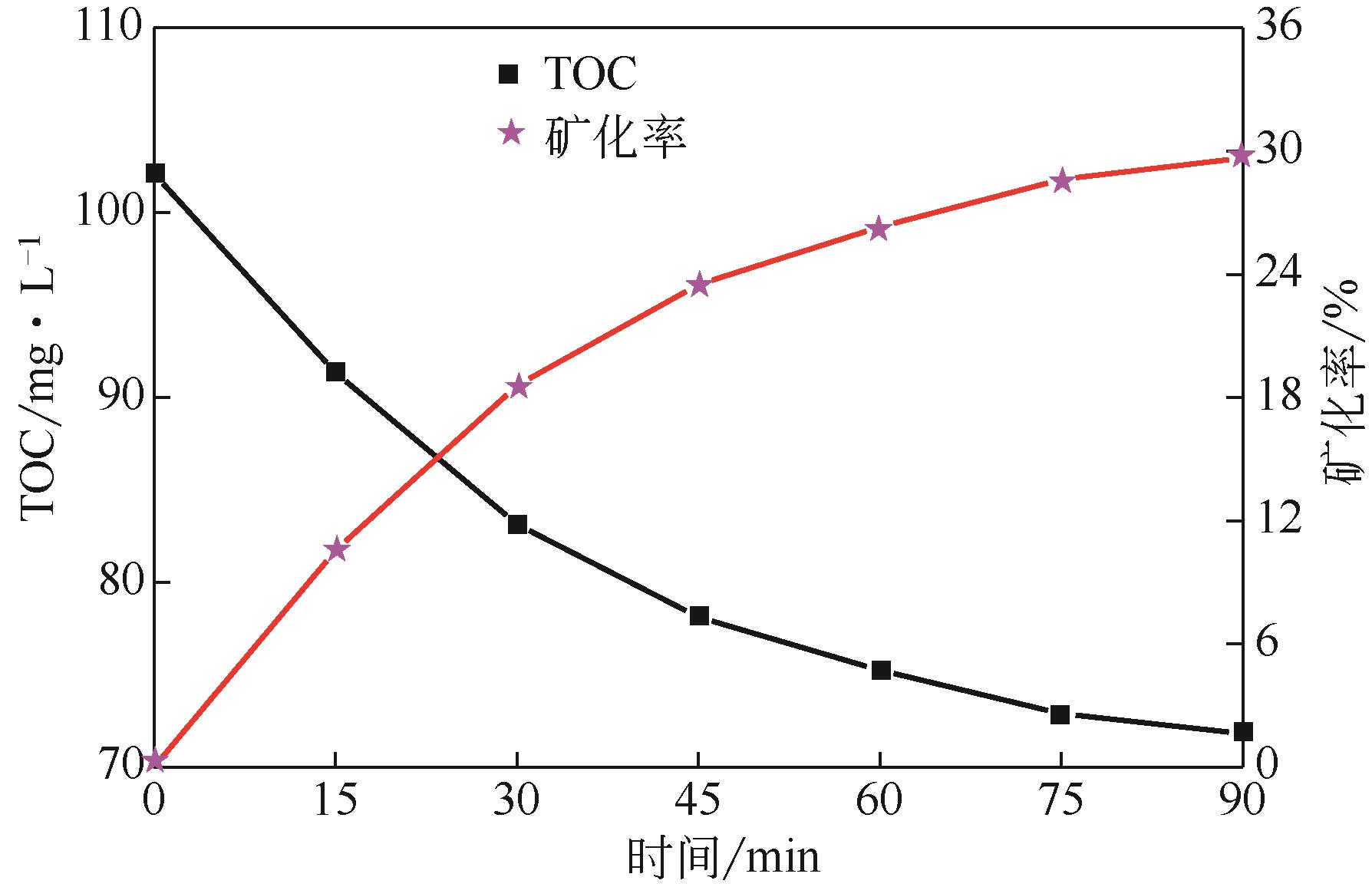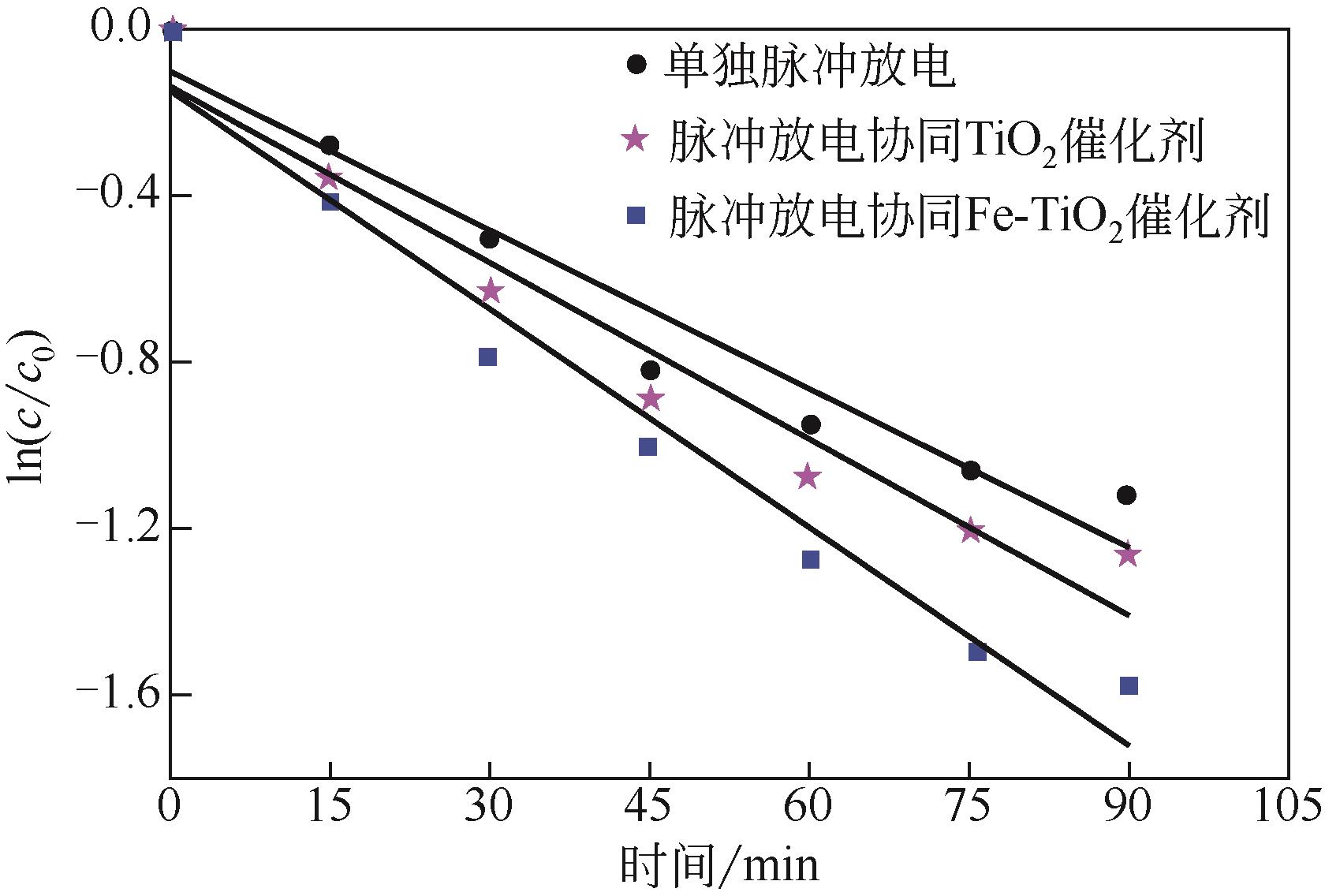化工进展 ›› 2021, Vol. 40 ›› Issue (12): 6721-6728.DOI: 10.16085/j.issn.1000-6613.2020-2573
脉冲气液两相放电等离子体耦合Fe改性的TiO2催化剂降解废水中的4-氯酚
- 江西理工大学资源与环境工程学院,江西 赣州 341000
-
收稿日期:2020-12-27修回日期:2021-05-04出版日期:2021-12-05发布日期:2021-12-21 -
通讯作者:董冰岩 -
作者简介:董冰岩(1974—),教授,博士生导师,研究方向为放电等离子体技术在环境保护中的应用。E-mail:dongbingyan1@sina.com 。 -
基金资助:国家自然科学基金(51567010)
4-Chlorophenol containing wastewater joint treated by pulsed discharge plasma in gas-liquid two phase and Fe-modified TiO2 catalyst
DONG Bingyan( ), LI Zhendong, WANG Peixiang, LUO Ting, ZOU Ying, TU Wenjuan
), LI Zhendong, WANG Peixiang, LUO Ting, ZOU Ying, TU Wenjuan
- College of Resources and Environmental Engineering, Jiangxi University of Science and Technology, Ganzhou 341000, Jiangxi, China
-
Received:2020-12-27Revised:2021-05-04Online:2021-12-05Published:2021-12-21 -
Contact:DONG Bingyan
摘要:
为了提高酚类废水的降解效果,本文以4-氯酚为处理对象建立了多针-板式高压脉冲气液两相放电等离子体催化体系。实验制备了系列催化剂并进行了表征分析,考察了各因素对4-氯酚降解的影响,并分析了降解过程总有机碳(TOC)、中间产物及其浓度变化。结果表明,催化剂焙烧温度及投加量对降解率有很大影响;4-氯酚浓度为150mg/L时,在电极间距10mm、脉冲电压26kV、脉冲频率70Hz、曝气量4L/min条件下,添加0.05g焙烧温度为500℃的Fe-TiO2催化剂与放电等离子体耦合降解效果最好。中间产物对苯酚、对苯醌、4-氯邻苯二酚在放电过程中浓度随着放电时间的延长先增大后减小,最后都趋于零。催化剂表征显示脉冲放电可以改变催化剂的晶形和结构,且掺杂Fe改性的Fe-TiO2催化性能较好,能进一步提升4-氯酚的降解率。
中图分类号:
引用本文
董冰岩, 李贞栋, 王佩祥, 罗婷, 邹颖, 涂文娟. 脉冲气液两相放电等离子体耦合Fe改性的TiO2催化剂降解废水中的4-氯酚[J]. 化工进展, 2021, 40(12): 6721-6728.
DONG Bingyan, LI Zhendong, WANG Peixiang, LUO Ting, ZOU Ying, TU Wenjuan. 4-Chlorophenol containing wastewater joint treated by pulsed discharge plasma in gas-liquid two phase and Fe-modified TiO2 catalyst[J]. Chemical Industry and Engineering Progress, 2021, 40(12): 6721-6728.
| 不同反应体系 | kcp/min-1 | R2 | 放电90min的 降解率/% |
|---|---|---|---|
| 单独脉冲放电 | 0.0127 | 0.9497 | 67.25 |
| 脉冲放电耦合TiO2催化剂 | 0.0141 | 0.9522 | 71.91 |
| 脉冲放电耦合Fe-TiO2催化剂 | 0.0175 | 0.9656 | 79.29 |
表1 不同反应体系的4-氯酚反应速度常数
| 不同反应体系 | kcp/min-1 | R2 | 放电90min的 降解率/% |
|---|---|---|---|
| 单独脉冲放电 | 0.0127 | 0.9497 | 67.25 |
| 脉冲放电耦合TiO2催化剂 | 0.0141 | 0.9522 | 71.91 |
| 脉冲放电耦合Fe-TiO2催化剂 | 0.0175 | 0.9656 | 79.29 |
| 1 | 王韬, 李鑫钢, 杜启云. 含酚废水治理技术研究进展[J].化工进展, 2008, 27(2):231-235. |
| WANG Tao, LI Xingang, DU Qiyun. Research progress of phenol-containing waste water disposal technique[J]. Chemical Industry and Engineering Progress, 2008, 27(2):231-235. | |
| 2 | OLIVEIRA A S, BAEZA J A, SAENZ DE MIERA B, et al. Aqueous phase reforming coupled to catalytic wet air oxidation for the removal and valorisation of phenolic compounds in wastewater[J]. Journal of Environmental Management, 2020, 274: 111199. |
| 3 | ZHANG Meng, ZHANG Zhi, LIU Shaocong, et al. Ultrasound-assisted electrochemical treatment for phenolic wastewater[J]. Ultrasonics Sonochemistry, 2020, 65: 105058. |
| 4 | HUONG D T, NGUYEN V T, HA X L, et al. Enhanced degradation of phenolic compounds in coal gasification wastewater by methods of microelectrolysis Fe-C and anaerobic-anoxic-oxic moving bed biofilm reactor (A2O-MBBR) [J]. Processes, 2020, 8(10): 1258. |
| 5 | SU Yanyu, LIU Shuai, ZHAO Chunfeng, et al. Needle electrode design of pulsed high voltage discharge reactor for performance enhancement of 4-chlorophenol degradation in highly conductive solution[J]. Chemosphere, 2020, 266: 129203. |
| 6 | DUAN Zhihui, ZHANG Wanhui, LU Muwen, et al. Magnetic Fe3O4/activated carbon for combined adsorption and Fenton oxidation of 4-chlorophenol[J]. Carbon, 2020, 167: 351-63. |
| 7 | LIU Chang, MIN Yuan, ZHANG Aiyong,et al. Electrochemical treatment of phenol-containing wastewater by facet-tailored TiO2: efficiency, characteristics and mechanisms[J]. Water Research, 2019, 165: 114980. |
| 8 | 李和平, 于达仁, 孙文廷, 等. 大气压放电等离子体研究进展综述[J]. 高电压技术, 2016, 42(12): 3697-3727. |
| LI Heping, YU Daren, SUN Wenting, et al. State-of-the-art of at-mospheric discharge plasmas[J]. High Voltage Engineering, 2016, 42(12): 3697-3727. | |
| 9 | 王方铮, 李杰, 吴彦, 等. 高压脉冲放电等离子体溶液中苯酚的降解[J]. 高电压技术, 2007(2): 124-127. |
| WANG Fangzheng, LI Jie, WU Yan, et al. Degradation of phenol in aqueous solution by high voltage pulsed discharge plasma[J]. High Voltage Engineering, 2007(2): 124-127. | |
| 10 | 董冰岩, 邓苇, 孙宇, 等. 高压脉冲放电协同纳米催化剂降解苯酚废水[J]. 高电压技术, 2017, 43(8): 2645-2652. |
| DONG Bingyan, DENG Wei, SUN Yu, et al. Phenol wastewater treatment by high voltage pulse discharge combined with nanometer catalyst[J]. High Voltage Engineering, 2017, 43(8): 2645-2652. | |
| 11 | 程爱华, 马万超, 徐哲. 等离子体改性海绵铁活化过硫酸盐处理含酚废水[J]. 化工进展, 2020, 39(2): 798-804. |
| CHENG Aihua, MA Wanchao, XU Zhe. Treatment of phenol wastewater with persulfate activated by plasmamodified sponge iron[J]. Chemical Industry and Engineering Progress, 2020, 39(2): 798-804. | |
| 12 | MA S, KIM K, CHUN S, et al. Plasma-assisted advanced oxidation process by a multi-hole dielectric barrier discharge in water and its application to wastewater treatment[J]. Chemosphere, 2020, 243: 125377. |
| 13 | ZAIDY S S H, VACCHI F I, UMBUZEIRO G A, et al. Approach to waterless dyeing of textile substrates-use of atmospheric plasma[J]. Industrial Engineering Chemistry Research, 2019, 58(40): 18478-18487. |
| 14 | SUN B, SATO M, CLEMENTS J SID. Optical study of active species produced by a pulsed streamer corona discharge in water[J]. Journal of Electrostatics, 1997, 39(3): 189-202. |
| 15 | JOSE J, RAMANUJAM S, PHILIP L. Applicability of pulsed corona discharge treatment for the degradation of chloroform[J]. Chemical Engineering Journal, 2019, 360: 1341-1354. |
| 16 | SINGH R K, PHILIP L, RAMANUJAM S. Rapid degradation, mineralization and detoxification of pharmaceutically active compounds in aqueous solution during pulsed corona discharge treatment[J]. Water Research, 2017, 121: 20-36. |
| 17 | 孙明, 金宏力, 杨颜颜, 等. 脉冲放电等离子体协同二氧化钛降解偶氮类染料废水[J]. 高电压技术, 2015, 41(9): 2862-2867. |
| SUN Ming, JIN Hongli, YANG Yanyan, et al. Degradation of azo dye wastewater using pulsed discharge plasma with TiO2[J]. High Voltage Engineering, 2015, 41(9): 2862-2867. | |
| 18 | ZHU Bin, ZHANG Luyao, YAN Yan, et al. Enhancing toluene removal in a plasma photocatalytic system through a black TiO2 photocatalyst[J]. Plasma Science and Plasma Technology, 2019, 21(11): 115503. |
| 19 | MOHAMMADI P, GHORBANI-SHAHNA F, BAHRAMI A, et al. Plasma-photocatalytic degradation of gaseous toluene using SrTiO3/rGO as an efficient heterojunction for by-products abatement and synergistic effects[J]. Journal of Photochemistry and Photobiology A: Chemistry, 2020, 394: 112460. |
| 20 | 董冰岩, 张鹏, 聂亚林, 等. 针-板式高压脉冲气液两相放电降解废水中的苯酚[J]. 化工进展, 2016, 35(1): 314-319. |
| DONG Bingyan, ZHANG Peng, NIE Yalin, et al. Phenol wastewater treatment by needle-plate pulsed high voltage discharge in gas-liquid two phase[J]. Chemical Industry and Engineering Progress, 2016, 35(1): 314-319. | |
| 21 | 董冰岩, 王慧, 张雨路. 高压脉冲放电降解4-氯酚废水的实验研究[J]. 化学工程, 2019, 47(2): 12-17. |
| DONG Bingyan, WANG Hui, ZHANG Yulu. Degradation of 4-chlorophenol wastewater by high voltage pulse discharge[J]. Chemical Engineering(China), 2019, 47(2): 12-17. | |
| 22 | 彭晓春, 陈新庚, 黄鹄, 等. n-TiO2光催化机理及其在环境保护中的应用研究进展[J]. 环境工程学报, 2002, 3(3): 1-6. |
| PENG Xiaochun. CHEN Xingeng, HUANG Hu,et al. The light catalytic mechanism of n-TiO2 and its application in the environmental protection[J].Chinese Journal of Environmental Engineering, 2002, 3(3): 1-6. | |
| 23 | 董冰岩, 施志勇, 何俊文, 等. 脉冲放电等离子体耦合Mn/TiO2分子筛、Fe/TiO2分子筛、Cu/TiO2分子筛催化剂降解甲醛[J]. 化工进展, 2015, 34(9): 3337-3344. |
| DONG Bingyan, SHI Zhiyong, HE Junwen, et al. Research of pulse discharge plasma combined with Mn/TiO2-molecular、Fe/TiO2-molecular、Cu/TiO2-molecular sieve catalysts decomposition of formaldehyde[J]. Chemical Industry and Engineering Progress, 2015, 34(9): 3337-3344. | |
| 24 | 闫鹏飞, 王建强, 江欣, 等. 掺铁TiO2纳米晶的制备及光催化性能研究[J]. 材料科学与工艺, 2002, 10(1): 28-31. |
| YAN Pengfei, WANG Jianqiang, JIANG Xin, et al. Preparation and photocatalytic properties of iron-doped TiO2 nanocrystal[J]. Materials Science and Technology, 2002, 10(1): 28-31. | |
| 25 | KOMARAIAH D, RADHA E, SIVAKUMAR J, et al. Structural optical properties and photocatalytic activity of Fe3+ doped TiO2 thin films deposited by sol-gel spin coating[J]. Surfaces and Interfaces, 2019, 17. |
| 26 | JRABA A, ANNA Z, ELALOUI E. Effects of Sr2+, Fe3+ and Al3+ doping on the properties of TiO2 prepared using the sol-gel method[J]. Comptes Rendus Chimie, 2019, 22(9/10): 648-658. |
| 27 | HARIFI T, MONTAZER M. Fe3+: Ag/TiO2 nanocomposite: synthesis, characterization and photocatalytic activity under UV and visible light irradiation[J]. Applied Catalysis A: General, 2014, 473: 104-115. |
| 28 | CUI Tao, SHEN Chenyang, XU Anlin, et al. Use of a novel coupled-oxidation tubular reactor (COTR)/NTP-DBD catalytic plasma in a synergistic electro-catalysis system for odorous mercaptans degradation[J]. Chemosphere, 2019, 216: 533-544. |
| 29 | GUO He, JIANG Nan, LI Jie, et al. Synergistic degradation of bisphenol A by pulsed discharge plasma with granular activated carbon: effect of operating parameters, synergistic mechanism and possible degradation pathway[J]. Vacuum, 2018, 156: 402-410. |
| 30 | HAO XiaoLong, ZHOU MingHua, XIN Qing, et al. Pulsed discharge plasma induced Fenton-like reactions for the enhancement of the degradation of 4-chlorophenol in water[J]. Chemosphere, 2007, 66(11): 2185-2192. |
| 31 | LI Shanping, WANG Xiaoping, LIU Lijun, et al. Enhanced degradation of perfluorooctanoic acid using dielectric barrier discharge with La/Ce-doped TiO2[J]. Environmental Science and Pollution Research, 2017, 24(18): 15794-15803. |
| [1] | 许春树, 姚庆达, 梁永贤, 周华龙. 共价有机框架材料功能化策略及其对Hg(Ⅱ)和Cr(Ⅵ)的吸附性能研究进展[J]. 化工进展, 2023, 42(S1): 461-478. |
| [2] | 赵景超, 谭明. 表面活性剂对电渗析减量化工业含盐废水的影响[J]. 化工进展, 2023, 42(S1): 529-535. |
| [3] | 葛全倩, 徐迈, 梁铣, 王凤武. MOFs材料在光电催化领域应用的研究进展[J]. 化工进展, 2023, 42(9): 4692-4705. |
| [4] | 王晨, 白浩良, 康雪. 大功率UV-LED散热与纳米TiO2光催化酸性红26耦合系统性能[J]. 化工进展, 2023, 42(9): 4905-4916. |
| [5] | 邵志国, 任雯, 许世佩, 聂凡, 许毓, 刘龙杰, 谢水祥, 李兴春, 王庆吉, 谢加才. 终温对油基钻屑热解产物分布和特性影响[J]. 化工进展, 2023, 42(9): 4929-4938. |
| [6] | 王琦, 寇丽红, 王冠宇, 王吉坤, 刘敏, 李兰廷, 王昊. 焦化废水生物出水中可溶解性有机物的分子识别[J]. 化工进展, 2023, 42(9): 4984-4993. |
| [7] | 史天茜, 石永辉, 武新颖, 张益豪, 秦哲, 赵春霞, 路达. Fe2+对厌氧氨氧化EGSB反应器运行性能的影响[J]. 化工进展, 2023, 42(9): 5003-5010. |
| [8] | 高聪, 陈城虎, 陈修来, 刘立明. 代谢工程改造微生物合成生物基单体的进展与挑战[J]. 化工进展, 2023, 42(8): 4123-4135. |
| [9] | 杨静, 李博, 李文军, 刘晓娜, 汤刘元, 刘月, 钱天伟. 焦化污染场地中萘降解菌的分离及降解特性[J]. 化工进展, 2023, 42(8): 4351-4361. |
| [10] | 姜晶, 陈霄宇, 张瑞妍, 盛光遥. 载锰生物炭制备及其在环境修复中应用研究进展[J]. 化工进展, 2023, 42(8): 4385-4397. |
| [11] | 郑梦启, 王成业, 汪炎, 王伟, 袁守军, 胡真虎, 何春华, 王杰, 梅红. 菌藻共生技术在工业废水零排放中的应用与展望[J]. 化工进展, 2023, 42(8): 4424-4431. |
| [12] | 储甜甜, 刘润竹, 杜高华, 马嘉浩, 张孝阿, 王成忠, 张军营. 有机胍催化脱氢型RTV硅橡胶的制备和可降解性能[J]. 化工进展, 2023, 42(7): 3664-3673. |
| [13] | 陈娜, 张肖静, 张楠, 马冰冰, 张涵, 杨浩洁, 张宏忠. 淬灭酶对亚硝化-混合自养脱氮系统的影响[J]. 化工进展, 2023, 42(7): 3816-3823. |
| [14] | 徐伟, 李凯军, 宋林烨, 张兴惠, 姚舜华. 光催化及其协同电化学降解VOCs的研究进展[J]. 化工进展, 2023, 42(7): 3520-3531. |
| [15] | 龚鹏程, 严群, 陈锦富, 温俊宇, 苏晓洁. 铁酸钴复合碳纳米管活化过硫酸盐降解铬黑T的性能及机理[J]. 化工进展, 2023, 42(7): 3572-3581. |
| 阅读次数 | ||||||
|
全文 |
|
|||||
|
摘要 |
|
|||||


